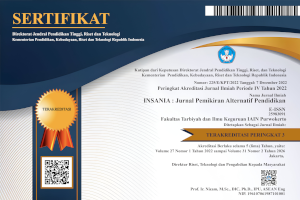Teori Kritis Habermas dan Relevansinya dengan Pendidikan
Teori Kritis Habermas dan Relevansinya dengan Pendidikan
DOI:
https://doi.org/10.24090/insania.v22i2.1207Keywords:
Jurgen Habermas, Critical Theory, EducationalAbstract
This paper examines the critical theory developed by Jurgen Habermas, a philosopher of the second-generation Frankfurt school of thought. Critical views of Habermas in social science that many social scientists studied can be implemented into the world of education and formulated into a model of critical education. Habermas's critical theory and theory of communicative action for educational sociology are used as models of how social theory can influence in shaping thought and action in education. Habermas's critical theory contributes in enlightenment to an education that is more humanizing to human beings, rather than seeing humans as empty papers that do not exist.Downloads
References
Budi Hardiman. 1993. Menuju Masyarakat Komunikatif, Ilmu, Masyarakat, Politik, dan Postmodernisme menurut Jurgen Habermas. Yogyakarta: Kanisius.
Franz Magnis-Suseno. 1992. Filsafat sebagai Ilmu Kritis. Yogyakarta: Kanisius.
George Ritzer dan Douglas J. Goodman. 2008. Teori Sosiologi: Dari Teori Sosiologi Klasik sampai Perkembangan Mutakhir Teori Sosial Postmodern, terj. Nurhadi, Yogyakarta: Kreasi Wacana.
Joy A. Palmer. 2006. Fifty Modern Thinker on Education: 50 Pemikir Paling berpengaruh dalam Pendidikan Modern. Yogyakarta: IRCiSoD.
Jurgen Habermas. 1971. Knowledge and Human Interest terj. Jeremy J. Saphiro. Boston: Beacon Press.
H.AR. Tilaar. 2002. Perubahan Sosial dan Pendidikan: Pengantar Pedagogik Transformatif untuk Indonesia. Jakarta: Grasindo.
Ian Craib. 1986. Teori-teori Sosial Modern: Dari Parsons Sampai Habermas, terj. Efendi. Jakarta: Grafindo Persada.
Philippe Cabin dan Jean Francois Dortier (ed). 2005. Sosiologi: Sejarah dan Berbagai Pemikirannya terj. Ninik Rochani Sjams. Yogyakarta: Kreasi Wacana.
Stevan M. Chan. 2002. Pendidikan Liberal Berbasis Sekolah. Yogyakarta: Kreasi Wacana.
Ziauddin Sardar. 1988. Tantangan Dunia Islam Abad 21: Menjangkau Informasi terj. A.E Priyono. Bandung: Penerbit Mizan.
Published
How to Cite
Issue
Section
License
Authors who publish with this journal agree to the following terms:
Authors retain copyright and grant the journal right of first publication with the work simultaneously licensed under a Creative CommonsAttribution-ShareAlike License that allows others to share the work with an acknowledgment of the work's authorship and initial publication in this journal.
Authors are able to enter into separate, additional contractual arrangements for the non-exclusive distribution of the journal's published version of the work (e.g., post it to an institutional repository or publish it in a book), with an acknowledgment of its initial publication in this journal.
Authors are permitted and encouraged to post their work online (e.g., in institutional repositories or on their website) prior to and during the submission process, as it can lead to productive exchanges, as well as earlier and greater citation of published work (See The Effect of Open Access).








